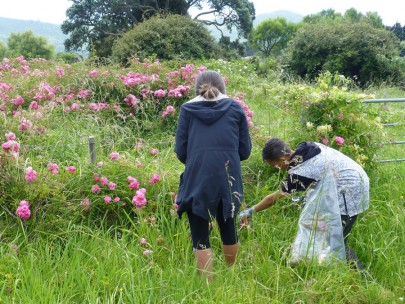TKKM O Kawakawa Mai Tawhiti, Gisborne
In this section
-
Participating schools
- Curious Minds visit Lincoln
- Franz Josef & Fox Glacier Schools
- Greymouth High School
- Haast School
- Halswell Domain
- Halswell School
- Heathcote Valley School
- Kaniere School
- Kaniere visit Lincoln
- Hokitika Primary
- Leeston Consolidated School
- Manuka Primary School
- Mission Heights
- Mt Albert Grammar
- Paroa School
- Rudolf Steiner School
- Takapuna Grammar
- TKKM
- Wakaaranga Primary School
- Whataroa School
TKKM is a Decile 1 full-immersion Te Reo (Maori language) school. Teacher Kararaina Ngatai-Melbourne looked after us very well and also explained some of the lessons we gave in English to her class in Te Reo. We were also introduced to Principal Papa Campbell who made us feel welcome. This visit proved to be one of our most rewarding and interesting.

TKKM students collecting wild roses in the field.
Our Auckland-based educator Monique Russell again partnered with Murray Dawson from Landcare Research (Lincoln) on this trip. Keen iNaturalist NZ contributor Mark Tutty of Gisborne joined us as a helper for our school visit. Mark proved to be great value and fully pitched in.
The three of us arrived at Hicks Bay on Wednesday afternoon and we just had time to teach a class of 12 Y8s in their science room.
The school kindly made the whole of Thursday available for a Y9–10 class of another dozen students, plus a few of the keener Y8s who rejoined us from the previous day. In the morning we studied weeds growing in the school grounds and in the afternoon we ventured further afield, across the road along the stream-side and out towards the local marae. Being such a rural school, the students are well connected with the land and were extremely adept at getting into hard to access places in their hunt for weeds – often in bare feet and providing a major contrast to the urbanised experience at Mission Heights!
Trudi Ngawhare from DOC (Gisborne) joined us on the Thursday field trip.
At the school prize-giving on Friday morning, Murray had the honour of speaking about our Unlocking Curious Minds project in front of the school and local community. Murray presented prizes to three students who were selected by the school as showing the greatest interest in our project. Frank received a smartphone and won the trip to Lincoln the following week; Phoenix and Kaia each won LED-illuminated hand lenses.
What were some of the plants that we found?
We found Tradescantia growing around the nearby stream sides. When visiting our research centre in Lincoln, Hugh Gourlay gave Frank a container of Tradescantia biocontrol beetles. Upon his return to Hicks Bay, Frank released them under the bridge where we found a large patch of this troublesome weed.
Other notable weeds in the district included abundant Chinese privet (Ligustrum sinense) and brush wattle (Paraserianthes lophantha). These seemed to be the dominant weedy tree species of our study area.
A selection of minor weeds not seen during visits to schools from other areas of New Zealand included:
- dragon's-head lily (Gladiolus dalenii)
- Indian-shot (Canna indica)
- large quaking grass (Briza maxima)
- love-in-a-mist (Nigella damascena).
Although we were concentrating on weeds, the students observed a few native plants too, including:
- kawakawa (Piper excelsum)
- shore bindweed (Calystegia soldanella)
- taupata (Coprosma repens)
- tree tutu (Coriaria arborea).
A plant that we originally misidentified as the invasive hanging sedge, Carex pendula, was later identified by the iNaturalist NZ community as Carex geminata, a native plant. This highlights the importance of accurate identification before considering any weed control measures.
Further afield, we observed raukumara (Brachyglottis perdicioides), also called East Cape brachyglottis, a local rare native shrubby daisy found growing just below our lodgings, and on our way home we paid homage to the famous Te Waha o Rerekohu, said to be the largest and the oldest pohutukawa (Metrosideros excelsa) in the world.












